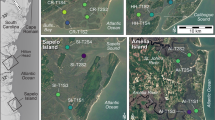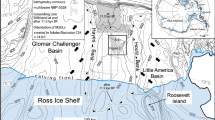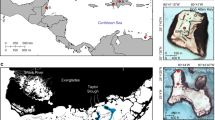Abstract
Coastal subsidence causes sea-level rise, shoreline erosion and wetland loss, which poses a threat to coastal populations1. This is especially evident in the Mississippi Delta in the southern United States, which was devastated by Hurricane Katrina in 2005. The loss of protective wetlands is considered a critical factor in the extensive flood damage. The causes of subsidence in coastal Louisiana, attributed to factors as diverse as shallow compaction and deep crustal processes, remain controversial2,3,4,5,6,7,8,9,10,11. Current estimates of subsidence rates vary by several orders of magnitude3,6. Here, we use a series of radiocarbon-dated sediment cores from the Mississippi Delta to analyse late Holocene deposits and assess compaction rates. We find that millennial-scale compaction rates primarily associated with peat can reach 5 mm per year, values that exceed recent model predictions5,9. Locally and on timescales of decades to centuries, rates are likely to be 10 mm or more per year. We conclude that compaction of Holocene strata contributes significantly to the exceptionally high rates of relative sea-level rise and coastal wetland loss in the Mississippi Delta, and is likely to cause subsidence in other organic-rich and often densely populated coastal plains.
This is a preview of subscription content, access via your institution
Access options
Subscribe to this journal
Receive 12 print issues and online access
$259.00 per year
only $21.58 per issue
Buy this article
- Purchase on Springer Link
- Instant access to full article PDF
Prices may be subject to local taxes which are calculated during checkout




Similar content being viewed by others
References
Jelgersma, S. in Sea-Level Rise and Coastal Subsidence. Causes, Consequences, and Strategies (eds Milliman, J. D. & Haq, B. U.) 47–62 (Kluwer, Dordrecht, 1996).
Morton, R. A., Bernier, J. C. & Barras, J. A. Evidence of regional subsidence and associated interior wetland loss induced by hydrocarbon production, Gulf Coast region, USA. Environ. Geol. 50, 261–274 (2006).
Dokka, R. K. Modern-day tectonic subsidence in coastal Louisiana. Geology 34, 281–284 (2006).
Dixon, T. H. et al. Subsidence and flooding in New Orleans. Nature 441, 587–588 (2006).
Meckel, T. A., Ten Brink, U. S. & Williams, S. J. Current subsidence rates due to compaction of Holocene sediments in southern Louisiana. Geophys. Res. Lett. 33, L11403 (2006).
Törnqvist, T. E., Bick, S. J., Van der Borg, K. & De Jong, A. F. M. How stable is the Mississippi Delta? Geology 34, 697–700 (2006).
González, J. L. & Törnqvist, T. E. Coastal Louisiana in crisis: Subsidence or sea level rise? Eos 87, 493–498 (2006).
Dokka, R. K., Sella, G. F. & Dixon, T. H. Tectonic control of subsidence and southward displacement of southeast Louisiana with respect to stable North America. Geophys. Res. Lett. 33, L23308 (2006).
Meckel, T. A., Ten Brink, U. S. & Williams, S. J. Sediment compaction rates and subsidence in deltaic plains: Numerical constraints and stratigraphic influences. Basin Res. 19, 19–31 (2007).
Chan, A. W. & Zoback, M. D. The role of hydrocarbon production on land subsidence and fault reactivation in the Louisiana coastal zone. J. Coast. Res. 23, 771–786 (2007).
Ivins, E. R., Dokka, R. K. & Blom, R. G. Post-glacial sediment load and subsidence in coastal Louisiana. Geophys. Res. Lett. 34, L16303 (2007).
Kaye, C. A. & Barghoorn, E. S. Late Quaternary sea-level change and crustal rise at Boston, Massachusetts, with notes on the autocompaction of peat. Geol. Soc. Am. Bull. 75, 63–80 (1964).
Bloom, A. L. Peat accumulation and compaction in a Connecticut coastal marsh. J. Sedim. Petrol. 34, 599–603 (1964).
Nadon, G. C. Magnitude and timing of peat-to-coal compaction. Geology 26, 727–730 (1998).
Pizzuto, J. E. & Schwendt, A. E. Mathematical modeling of autocompaction of a Holocene transgressive valley-fill deposit, Wolfe Glade, Delaware. Geology 25, 57–60 (1997).
Allen, J. R. L. Geological impacts on coastal wetland landscapes: Some general effects of sediment autocompaction in the Holocene of northwest Europe. Holocene 9, 1–12 (1999).
Long, A. J., Waller, M. P. & Stupples, P. Driving mechanisms of coastal change: Peat compaction and the destruction of late Holocene coastal wetlands. Mar. Geol. 225, 63–84 (2005).
Cahoon, D. R., Reed, D. J. & Day, J. W. Jr. Estimating shallow subsidence in microtidal salt marshes of the southeastern United States: Kaye and Barghoorn revisited. Mar. Geol. 128, 1–9 (1995).
Penland, S. & Ramsey, K. E. Relative sea-level rise in Louisiana and the Gulf of Mexico: 1908–1988. J. Coast. Res. 6, 323–342 (1990).
Kulp, M. A. Holocene Stratigraphy, History, and Subsidence of the Mississippi River Delta Region, North-Central Gulf of Mexico. Thesis, Univ. Kentucky (2000).
Törnqvist, T. E. et al. A revised chronology for Mississippi River subdeltas. Science 273, 1693–1696 (1996).
Törnqvist, T. E. & Van Dijk, G. J. Optimizing sampling strategy for radiocarbon dating of Holocene fluvial systems in a vertically aggrading setting. Boreas 22, 129–145 (1993).
Cohen, K. M. in River Deltas—Concepts, Models, and Examples (eds Giosan, L. & Bhattacharya, J. P.) 341–364 (SEPM (Soc. Sedim. Geol.), Tulsa, Spec. Publ., Vol. 83, 2005).
Mesri, G., Stark, T. D., Ajlouni, M. A. & Chen, C. S. Secondary compression of peat with or without surcharging. J. Geotech. Geoenviron. Engrg. 123, 411–421 (1997).
Filgueira-Rivera, M., Smith, N. D. & Slingerland, R. L. Controls on natural levée development in the Columbia River, British Columbia, Canada. Sedimentology 54, 905–919 (2007).
McFarlan, E. Jr. Radiocarbon dating of late Quaternary deposits, south Louisiana. Geol. Soc. Am. Bull. 72, 129–158 (1961).
Coleman, J. M. Deltas. Processes of Deposition and Models for Exploration (Burgess, Minneapolis, 1981).
De Groot, Th. A. M. & De Gans, W. Facies variations and sea-level-rise response in the lowermost Rhine/Meuse area during the last 15000 years (the Netherlands). Meded. Rijks Geol. Dienst 57, 229–250 (1996).
Day, J. W. Jr et al. Restoration of the Mississippi Delta: Lessons from Hurricanes Katrina and Rita. Science 315, 1679–1684 (2007).
Törnqvist, T. E. et al. Comment on “Wetland sedimentation from Hurricanes Katrina and Rita”. Science 316, 201b (2007).
Acknowledgements
This analysis is based mainly on field data collected from 1993 to 1995, supported by grant 770-07-238 from the Netherlands Organisation for Scientific Research (NWO). Further funding was provided by NOAA and USGS to the Long-term Estuary Assessment Group through the Center for Bioenvironmental Research at Tulane and Xavier Universities, and by the Koninklijke/Shell Exploratie en Produktie Laboratorium. We benefited greatly from comments by T. Meckel. This paper is dedicated to the late Henk Berendsen, whose deep understanding of alluvial stratigraphy has had a profound impact on the work presented here.
Author information
Authors and Affiliations
Corresponding authors
Rights and permissions
About this article
Cite this article
Törnqvist, T., Wallace, D., Storms, J. et al. Mississippi Delta subsidence primarily caused by compaction of Holocene strata. Nature Geosci 1, 173–176 (2008). https://doi.org/10.1038/ngeo129
Received:
Accepted:
Published:
Issue Date:
DOI: https://doi.org/10.1038/ngeo129
This article is cited by
-
Shallow-subsidence vulnerability in the city of New Orleans, southern USA
Hydrogeology Journal (2024)
-
Shallow-Water Habitat in the Lower Columbia River Estuary: A Highly Altered System
Estuaries and Coasts (2024)
-
Responses of Coastal Wetlands to Rising Sea-Level Revisited: The Importance of Organic Production
Estuaries and Coasts (2024)
-
A new approach to describe the depositional architecture of interbedded thin coal seams using a proportional thickness model database
Acta Geophysica (2022)
-
Application of novel ensemble models and k-fold CV approaches for Land subsidence susceptibility modelling
Stochastic Environmental Research and Risk Assessment (2022)



